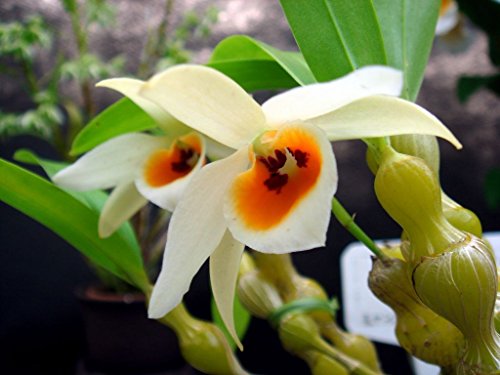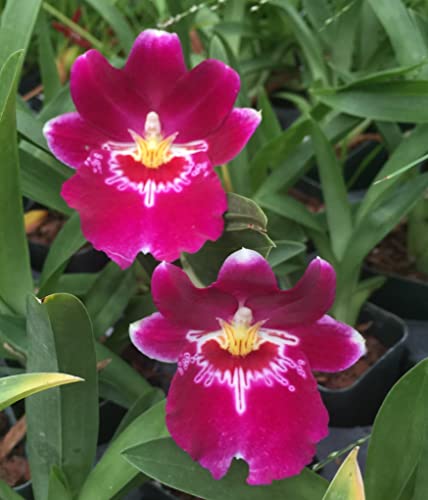There are over 25,000 species of orchids. So they’re a diverse group! In fact they’re one of the largest families of flowering plants on earth.
So as there’s an awful lot of orchids available to you. Which means it can be a bit daunting to try and pick the right variety to grow in your home. Thankfully many of those varieties can adapt well to the conditions you find inside our homes.
So I’m going to go through some of best and most beautiful orchid varieties that are perfect for growing indoors but that will also bring a bit of exotic charm to your home. As long as you care for them well you can have some breathtaking flowers and blooms all year.
Phalaenopsis (Moth Orchid)
Phalaenopsis, or moth orchids, are by far the most popular choice for growing orchids indoors. A big part of that is because of how easy to care for they are. So a great choice for beginners. On top of that they bloom for several months so you get to enjoy them for a good portion of the year.
Their flowers, come in a range or colors from pinks and purples to yellow. They look a lot like moths as they’re in flight and that’s where they get their name from.
Care Tips
Light: Bright, indirect light is ideal. Don’t put them in direct sunlight as it can burn the leaves.
Watering: Water once a week and let the potting mix to dry slightly between waterings.
Humidity: Maintain humidity at around 50 to 70%.
Cattleya (Corsage Orchid)
Cattleya orchids, often referred to as the “queen of orchids”, have very large flowers. They were once a used for corsages which is how they got their nickname. Cattleyas need a bit more care and looking after than Phalaenopsis but are well worth the effort when you see their spectacular flowers.
Care Tips
Light: They need bright light and can tolerate some direct sunlight.
Watering: Water thoroughly when the potting medium is dry to the touch, which should be about every 7 to 10 days.
Temperature: They like warmer temperatures but can handle cooler nights.
Dendrobium
Dendrobium orchids have a big range of species and hybrids and are pretty popular. They have flowers that last for quite a while and come in lots of colors and forms.
Some of the more common types for indoor growing include Dendrobium nobile and Dendrobium phalaenopsis.
Care Tips
Light: Bright, indirect light is necessary. Some species can tolerate more light than others.
Watering: Need to be watered regularly, especially during the growing season.
Temperature: Dendrobiums prefer warmer days and cooler nights.
Oncidium (Dancing Lady Orchid)
The Oncidium orchids, known as Dancing Lady orchids, have very noticeable multi flowered sprays that look a lot like a dancing figure. They are great for people who want an orchid that gives you a lot of large flowers all at once.
Care Tips
Light: They need bright light, similar to Cattleya orchids, and can even handle some direct sun.
Watering: Oncidiums like to be kept slightly moist throughout their growing season.
Humidity: Keep the humidity levels higher, somewhere around 60-80%, and you’ll get the best growth.
Paphiopedilum (Lady’s Slipper Orchid)
Paphiopedilum orchids, or Lady’s Slipper orchids, have a unique look with flowers that have a sort of pouch. They’re very popular and sought after for those unusual flowers. They do well in indoors with a little extra care.
Care Tips
Light: They prefer low to medium light levels. So definitely a good choice for rooms that get less natural light.
Watering: Keep the potting medium evenly moist but never let it get soggy.
Temperature: Cool to intermediate temperatures are best with a slight drop at night.
Cymbidium (Boat Orchid)
Cymbidium orchids have amazing flower spikes which can carry up to 30 blossoms at a time. Unlike a lot of other orchids they can tolerate cooler conditions. So a good choice for homes that cant keep tropical temperatures all year round.
Care Tips
Light: Bright light is really important. Although they should be protected from direct midday sun.
Watering: Like to be kept moist, especially when they are actively growing.
Temperature: Do best in cooler temperatures, so good if you live in cooler climates.
Miltoniopsis (Pansy Orchid)
The Miltoniopsis, or Pansy Orchid, had large, flat faced flowers that look a lot like pansies. They are quite difficult to grow though. If you get it right they’re wonderful and have lovely blooms.
Care Tips
Light: Moderate light is best. Make sure you set up some protection from harsh, direct sunlight though.
Watering: Keep the potting medium moist at all times. They do not it like to dry out.
Humidity: High humidity, around 70-80%, is key to get them to grow well.
Ludisia (Jewel Orchid)
Unlike other orchids, Ludisia, commonly known as the Jewel Orchid, is grown more for its foliage and leaves than its flowers. Those leaves are dark with distinct veins and will be a real showstopper in your home.
Care Tips
Light: Low to moderate light is good enough. So works well for darker rooms.
Watering: Water regularly but make sure the potting medium drains well so you don’t get root rot.
Temperature: They prefer warm, humid environments but can adapt to average indoor conditions.
How to Care for Your Indoor Orchids
Each orchid variety will have it’s own specific needs but there are some general tips that will apply to all orchids.
Light
Most orchids prefer bright, indirect light. East facing windows are usually a good and safe choice as they will have morning sunlight without the intensity of afternoon sun. And if your orchid isn’t blooming it might not be getting enough light.
Watering
Overwatering is probably the most common mistake when looking after orchids. You should be letting the potting mix to dry out slightly between waterings.
And always make sure the pot your orchid is in has good drainage. Watering once a week is usually enough but it can vary depending on the species and the environment it’s in.
Humidity
Higher humidity is preferable for most orchids. Something around 50 to 70%.
You can increase the humidity by putting your orchid on a tray filled with pebbles and water or by using a room humidifier.
Fertilizing
Orchids don’t need much on the way of fertilizer. When you do feed them use a balanced orchid fertilizer and dilute it by half.
Fertilize every couple of weeks during the growing season and then bring that down to once a month when it’s dormant.
Repotting
Repotting should be done once every 2 to 3 years. Refreshing the potting medium will help get rid of any issues and a new pot will give it more room to grow.
The best time to repot is after the orchid has finished blooming.
Final Thoughts
Getting the right variety will help you to have success with your orchid. You want one that matches your environment and you are able to care for properly. Get that right and even if you’re a total beginner you will have success growing and looking after an orchid.
You can start with the easy going Phalaenopsis or maybe challenging yourself with a Miltoniopsis. Whichever you choose there’s an orchid that is right for your home or garden and you will be able to enjoy.









